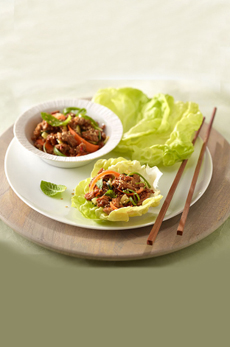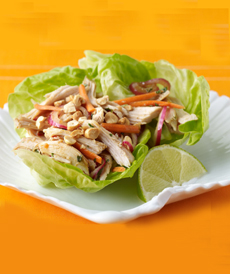TIP OF THE DAY: Lettuce Wraps
|
We love to start the new year with lettuce wraps instead of bread-based sandwiches. You can substitute your meat of choice (it’s a great way to use up leftovers) or create vegetarian versions. The first recipe is simpler in flavor profile, and uses ground turkey cooked from scratch. The second recipe is more complex in flavor, and uses leftover roast turkey. RECIPE: CHINESE LETTUCE WRAPS |

Chinese lettuce wraps with turkey, flavored with hoisin sauce, soy sauce and hot sauce. Photo courtesy Jennie-O. |
|
|
Preparation 1. COOK the turkey as specified on the package. (Always cook turkey to well-done, 165°F, as measured by a meat thermometer.) 1. HEAT the oil in a skillet over medium-high heat. Add the onions and sauté for 3 minutes or until they begin to brown. Mix in the turkey, sweet and spicy pepper sauce, hoisin sauce, soy sauce and cucumber. Heat through. 3. MAKE the wraps: Spoon the turkey mixture onto lettuce leaves and the wrap leaves around filling. |
||
 Turkey wraps with the filling spooned into a lettuce cup, salad style. Photo courtesy Jennie-O. |
RECIPE: THAI LETTUCE WRAPS This recipe uses leftover cooked turkey, although you can cook raw, ground turkey as in the previous recipe. There are more ingredients, resulting in more authentic, complex flavors. The reason this is a “Thai” wrap instead of a “Chinese” wrap is the Thai cuisine ingredients and seasonings: lime juice, grated ginger, fresh mint and cilantro, shredded carrots, fish sauce and sweet chili sauce. Prep time is less than 15 minutes; total time is less than 30 minutes. Ingredients For 4 Servings |
|
|
Preparation 1. COMBINE the onion and lime juice in small bowl; let stand 15 minutes. 2. HEAT a large, non-stick skillet over medium-high heat. Add the oil, ginger and garlic. Cook 1 minute or until fragrant. Remove the skillet from the heat. 3. COMBINE the onion mixture, turkey, mint, cilantro, sauces and carrot in large bowl. Spoon the turkey mixture into each lettuce leaf and sprinkle with peanuts. Hoisin sauce is a thick, sweet-and-pungent condiment that’s used in Asia much the way we use barbecue sauce (but the taste is completely different). It can be used to coat meat and poultry prior to cooking, it can be stirred into dishes and, as in the case of Peking Duck, it can be used as the principal condiment—a very elegant “ketchup.” The flavor of hoisin sauce has always seemed pruny-plummy to us (in the sense of a sweet fruitiness of roasted plums). In fact, recipes for a hoisin sauce substitute can include prunes. However, there’s no fruit in traditional hoisin sauce; unless you count a touch of chiles, which are, by botanical definition, fruits. The base of hoisin sauce is soybean paste, which is flavored with garlic, vinegar and sometimes some other spices. The resulting sweet-and-spicy paste is extremely flavorful and may overwhelm people who try it the first time. But keep trying; you’ll learn to love it.
|
||


